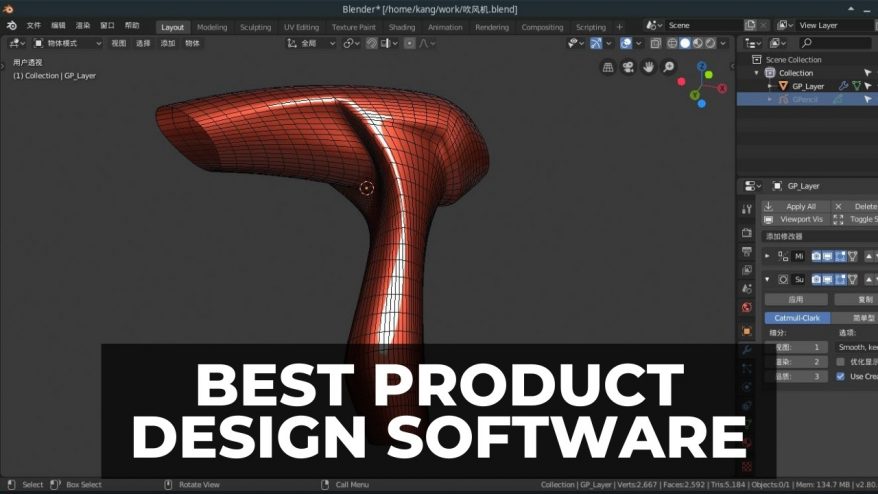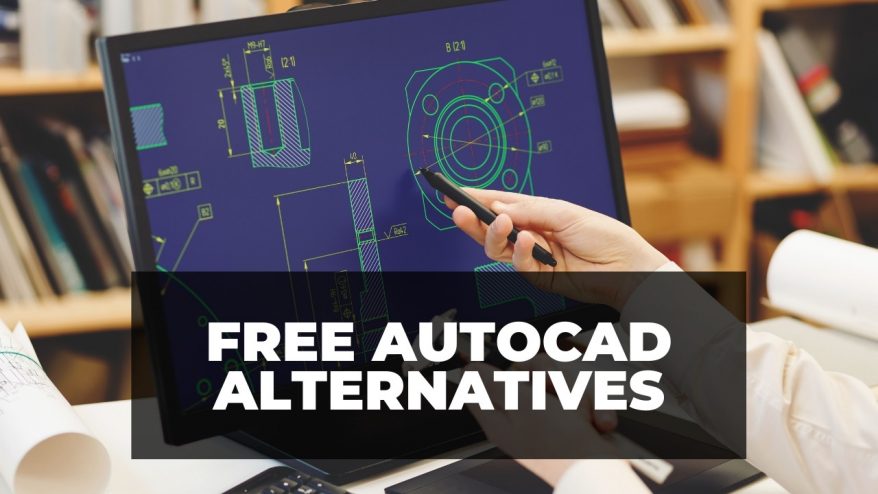Printed circuit boards are widely used by electrical engineers in a whole range of different products and applications. The first step in making a PCB is finding the best PCB design software which allows you to design a board’s layout – but which program is number one?
That’s what we reveal in this guide, where we review the top PCB design software tools out there to help you find the right match – and we have specific recommendations based on your current needs.
If you’re after the best overall PCB design software, few programs rival Altium Designer, but expect to pay for the pleasure.
For those on a tighter budget, KiCad comes in a close second, but is 100% free with no limitations and full functionality.
EasyEDA is a popular pick among designers, that is if you don’t mind the occasional ad.
And Upverter is arguably the best option for first timers or educators looking for a shallow learning curve and easy introduction to PCB design.
Best PCB Design Software – Full Round-Up
Top Picks
- Altium Designer: Overall Best PCB Design Software on Windows, Most Popular Among Professionals
- KiCad – Best Free PCB Design Software
- EasyEDA – Best Browser-Based PCB Design Software
- Upverter – Best PCB Design Software for Students and Education
- DipTrace – Best Easy-to-use Advanced PCB Design Software
- LibrePCB – Best Open Source PCB Design Software
- Fusion 360/Eagle: Best Free PCB Design Software for Mac & Linux
More Free Choices
- CircuitMaker: Best for Beginners Using Windows
- Fritzing: Best Open Source PCB Software
Other Professional Tools
- PADS: Powerful Circuit Board Designer for Professionals & Startups
1. Altium Designer – Overall Best PCB Design Software on Windows, Most Popular Among Professionals
- Price: from $330 per month
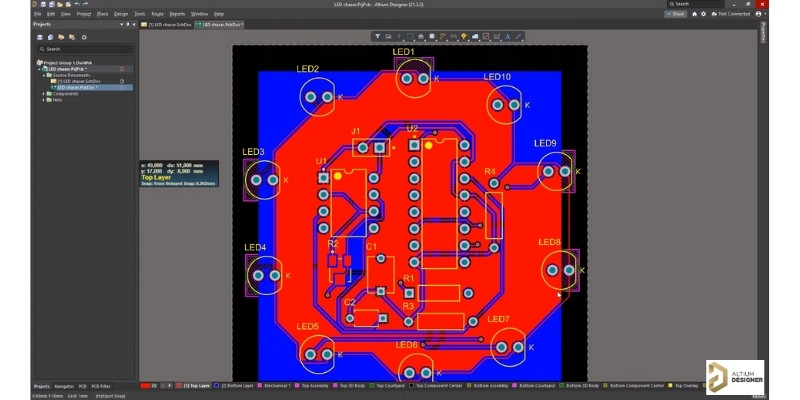
Pros
Industry leading software used by top tech companies
Design in unified photorealistic 3D environment
Highly efficient and precise interactive routing
Advanced tools for finding and managing parts, data, and suppliers
Cloud based and highly collaborative
Cons
Not available on Mac or Linux
Altium Designer is one of the most popular PCB board software on the market and is used by engineers across the world, including those working for leading tech companies like Amazon, Facebook, Dell, Microsoft, and Arduino.
Altium provides a truly unified, photorealistic 3D design environment, with a single view of every step of the PCB design process. Having all the design tools and documentation across one intuitive platform really helps to streamline your design workflow.
The interactive routing tools allow you to route PCB layouts from any angle at fast speeds, while the Layer Stackup feature helps to reduce noise and improve signal timing even on highly complex circuit boards.
Other impressive features include the Variant Manage for creating unique versions of your PCBs based on global market demands, a Manufacturer Part Search that simplifies the component creation process to reduce design time, and the Real Time BOM Management tool that lets you manage components, suppliers, and sourcing data.
Altium Designer is also cloud-based and one of the best PCB layout design software for collaboration, as you can share and review designs on any device with an internet connection.
On top of that, it’s great for collaborating with mechanical teams thanks to its seamless integration with tools like Solidworks, Fusion 360, and PTC Creo, with every design change synced between programs.
Overall, it’s probably the most comprehensive and highest quality PCB design solution money can buy. The only downside is it’s only available on Windows.
2. KiCad – Best Free PCB Design Software
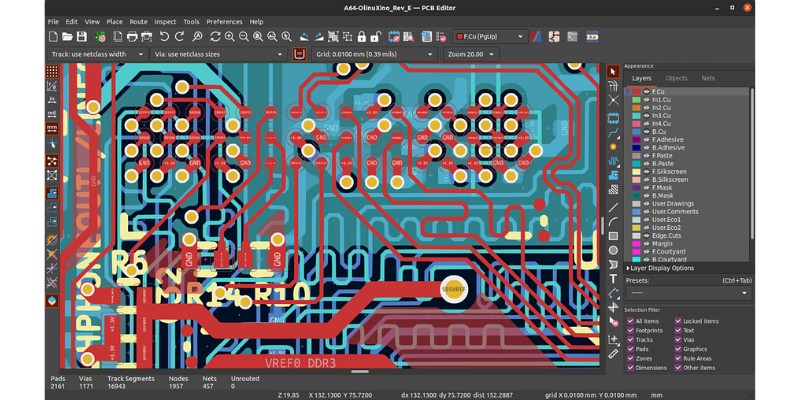
Pros
Free and open source
Large community
Plugins
Suitable for everyone from beginners to seasoned designers
Cons
Better UI elsewhere
KiCad is free, which makes it worth considering out of the gate. But with over three decades of development and countless improvements over the years, it’s a powerful PCB design tool that rivals many of the paid options. Suitable applications include single-board computers, motor controllers, custom mechanical keyboards, drones, smartwatches, low-power cameras, and much more.
KiCad features a schematic editor, suitable for everything from simple designs all the way to complex multi-sheet projects. The editor also has an integrated SPICE simulator for testing the viability of circuits before porting them to the real world. Alongside, there’s a robust PCB layout editor with a 3D and Gerber viewer, DRC scripting support, and support for designs from CAD software like EAGLE and the Altium suite.
Beyond the stacked selection of standard tools, KidCad accepts plug-ins, allowing you to adapt the software to your needs with options such as mechanical keyboard design, on-board designs, RF, and much more.
These plugins are supplemented by a vibrant community, meaning you’re never too far from finding a fix should you encounter any issues. The UI isn’t quite as appealing as other options, but remains simple enough to not overwhelm beginners and feature-rich enough to satisfy even the most demanding PCD designers.
3. EasyEDA – Best Browser-Based PCB Design Software
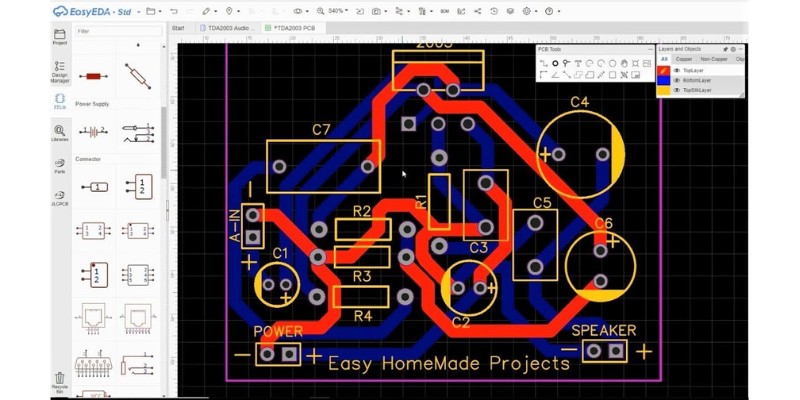
Pros
Browser-based version
Standlone version
Beginner-friendly
Full suite of PCB design tools
Cons
Free standard version has ads
Not suitable for advanced design projects
In a nod to accessibility, EasyEDA dodges the need for a beefy PC to create and render PCB designs with a browser-based option that works whether you’re on Windows, Mac, Linux, or even a smartphone. But this dedication to convenience and the fact it’s cloud-based doesn’t come at the expense of functionality.
It’s a fully-fledged PCB design suite with a host of features. These include a PCB design editor, schematic capture, 3D viewer, dimension checker, integrated team collaboration tools, an auto router, project and design management tools, and a heaped library of designs to inspire and kick start projects.
In our opinion, EasyEDA is a solid option for beginners and intermediate designers looking to power a range of projects thanks to a simple and intuitive UI. Possible applications include single board computers, microchips, motherboards, Raspberry Pi add ons, and much more. Though adoption is quite as big as other big name PCB design options, the EasyEDA is reasonably large, with tutorials, guides, and support to help you make the most of the software.
If the browser version isn’t for you, there’s also a standalone version. EasyEDA is available in two tiers – a free version supported by ads and a paid professional/enterprise, that’s ad free and features improved collaboration tools and customer support. EasyEDA also features LCSC parts and JLCPCB PCB ordering, so you can turn your project into a physical PCB quickly and efficiently.
4. Upverter – Best PCB Design Software for Students and Education
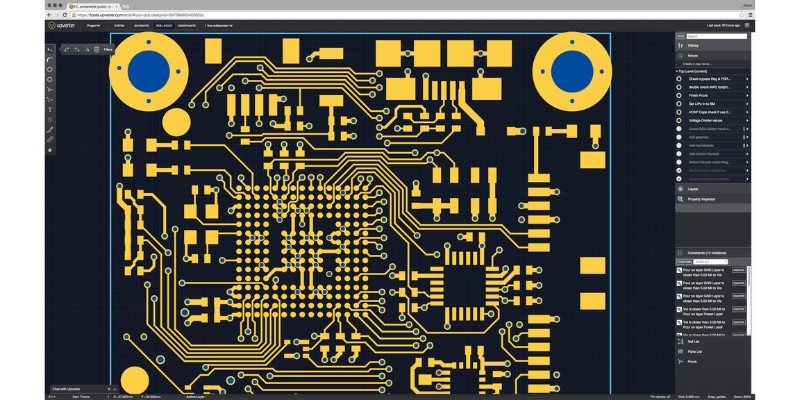
Pros
Clean, simple, beginner-friendly UI
Browser-based
Massive template library to kick start projects
PCB manufacturing service
Free teaching resources and lessons
Cons
Not suitable for advanced PCB design
Upverter is a browser-based program that’s mainly aimed at introducing students to the PCB design. Electronics and PCB design can be complex, but Upverter aims to simplify the process, starting with one of the simplest and cleanest user experiences and UIs out there. It’s also modular with a drag and drop design, making it intuitive for beginners with no prior knowledge of the subject.
Under the hood, it houses all the functionality you’d expect – schematics, PCB design, 3D viewer, automated routing, and collaboration tools. There’s also a quickstart template library with hundreds of boards to choose from, ideal for starting a project, especially in an educational context. And, should you want to bring your designs to life, there’s an integrated hassle-free manufacturing option for your custom-made PCBs, which are tested before delivery.
The focus on ease of use is bettered by a library of free teaching resources and lessons that help students learn and understand fundamental concepts of PCB design and complete their first project.
While Upverter is an ideal starting point for students and beginners, it lacks the advanced functionality of other options. Experienced designers may find the offering a little too light for advanced projects and will be better off choosing a more robust suite such a KiCad.
5. DipTrace – Best Easy-to-use- Advanced PCB Design Software
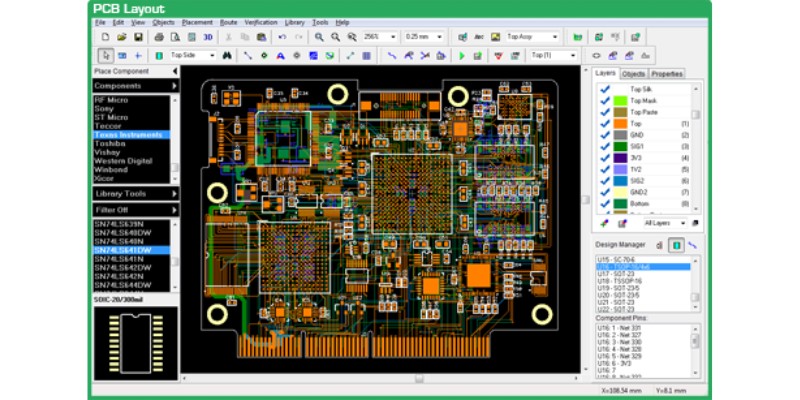
Pros
Easy to use drag-and-drop UI
Full suite of schematic and design tools
Extensive library of parts, components, and templates
Cons
No free version for commercial use
Designed by Novarm, DipTrace aims to bring full PCB design options and functionality while keeping the experience simple and intuitive. It’s one for advanced users that want the ease of use of a drag-and-drop modular system that can bring to life complex, robust PCB designs for applications such as single board computers, consumer products, educational projects, and much more.
DipTrace bundles in all the typical functionality – schematics, PCB layout design with autorouting, Gerber output, and real-time DRC, 3D modeling viewer, and a stacked library full of editing tools, templates, over 160,000 packaged components, and over 10 million parts. The program also features advanced rule verification, including SPICE export and simulation to ensure your work is fit for purpose.
If you stumble into any issues, DipTrace comes with some of the best support options on the market and a thriving community that has pieced together a huge archive of guides and videos to help you troubleshoot any issues.
DipTrace is license based with quite a few buying options, the cheapest of which is the DipTrace starter at $75, which include 300 pins and 2 signal layers. Students and educational institutions can get DipTrace Lite (capped at 500 pins and 2 signal layers) for free.
There’s also a non-profit version that’s 100% free but limited to 500 pins and 2 signal layers, rising to $350 for unlimited functionality. For the full fat version for commercial use with unlimited pins and signal layers, expect to pay around $1000.
6. LibrePCB – Best Open Source PCB Design Software
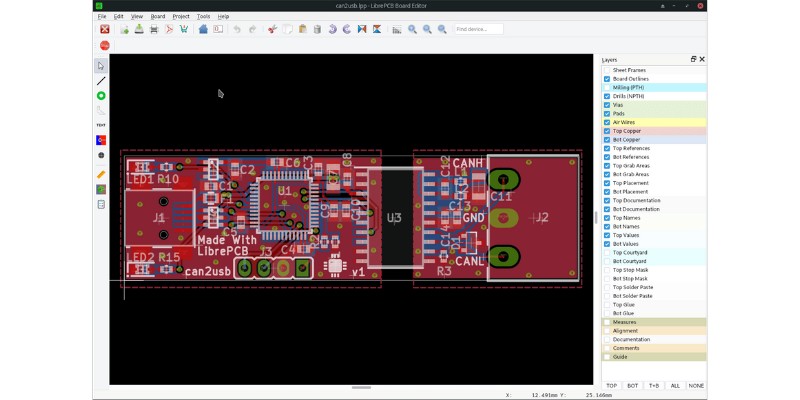
Pros
100% free
Simple and intuitive UI
Suitable for everyone from beginners to experienced professional designers
Cons
No 3D visualizer
LibrePCB aims to deliver free, open source, and easy-to-use PCB design for everyone from students and hobbyists to experts and professional designers. There are no strings, restrictions, or caveats, you get full functionality at zero cost whatever your skill level or the project.
One of the major highlights is the simple, intuitive, and easy-to-learn user interface, which removes a steep learning curve with a logical layout that’s easy to navigate even if you’re using PCB design software for the first time. Basic tasks are easy to perform, but advanced features are only a few clicks away, ensuring you can get designing quickly but won’t be limited down the line as you develop your design skills.
LibrePCB features a detailed schematics editor, PCB board editor, and a built-in library manager pooled from LibrePCB’s official libraries and third-party component libraries. The integrated LibrePCB Fab service also allows for easy PCB ordering through Aisler with a portion of profits fed back into the development of the program.
It does lack a 3D visualizer, which feels like a missed opportunity given it’s become almost a standard feature and one most PCB design software offers. Due to a limited LibrePCB user base, guides, tutorials, and videos are less prevalent than other competing options, but the simplicity of the design process means you should get by without needing much support.
7. Eagle – Best Free PCB Design Software for Mac & Linux
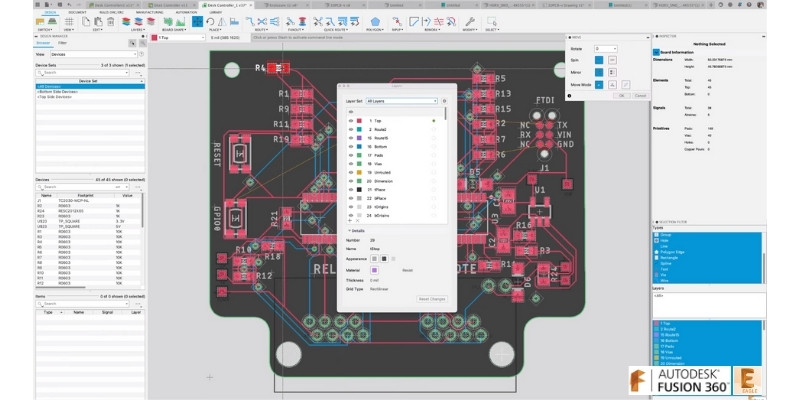
Pros
Complete free for hobbyists for three years
PCB program within wider CAD/CAM/CAE software
Highly intuitive PCB routing tools
Dynamic parts library
Generate accurate 3D PCB models
Cons
Can’t be used for commercial projects
Free version has limited sheets, layers, and board area
Fusion 360 is a popular CAD, CAM, CAE, and PCB software from Autodesk. It ships with its own circuit board design software, called Fusion 360 Electronics. But thanks to the buyout of CadSoft, the original developer, Fusion 360 now comes with a standalone PCB design program called Eagle. You’ll need a Fusion 360 subscription to use Eagle.
Eagle is a fairly straightforward tool that has all the features you need to make PCB designs. The schematic editor has a SPICE simulator that allows you to quickly test ideas, as well as electronic rule checks to validate circuit performance. The modular design blocks use a simple drag-and-drop method that you can use to add blocks to different projects.
The PCB layout tools are similarly intuitive, with helpful alignment tools and real-time synchronization to ensure your schematic and layout designs are always in sync. It uses interactive push and shove routing with obstacle avoidance features and tools for completing loop removal, cornering, and other functions quickly.
Autodesk offers fantastic support and learning resources for Eagle, and it’s one of the most widely compatible CAD PCB software, being available on Mac, Windows, and Linux.
Plus, as it’s technically part of Fusion 360, you have seamless integration with a vast array of advanced CAD, CAM, and CAE tools, making it a great all-in-one solution for many electrical engineering applications.
Bear in mind that the free version of Eagle is limited in comparison to the paid version (only two sheet and two signal layers design, which is used by many professional PCB design companies. With the paid Eagle software for PCB you’re not limited to the two schematic sheets, two signal layers, or the 80 cm squared board area that you get in the free version.
Free PCB Layout Software Options
8. CircuitMaker – Best Free PCB Design Software for Beginners & Windows
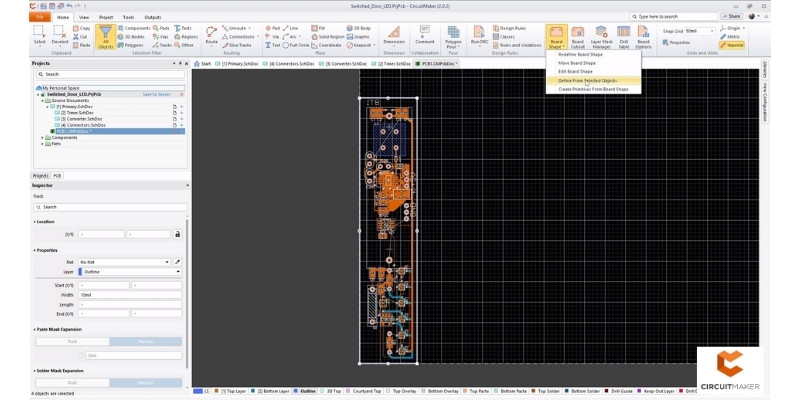
Pros
Extremely intuitive interface
Powerful interactive routing tools
Large and active user community
Great for collaboration
View PCB layouts as 3D models
Cons
Only available on Windows
Limited to five projects
CircuitMaker is a free and easy PCB design software developed by Altium, which also provides some of the top industrial PCB software (more on that later).
It boasts the same intuitive interface and sleek design as Altium’s professional solutions, making it one of the best PCB software for beginners and hobbyists. It allows you to design with up to 16 signal and 16 plane layers, with no limits on dimensions. You can create up to five projects.
CircuitMaker is very community-driven, and the community library has hundreds of thousands of components you can use completely free. All you need to do to add components is search by manufacturer part number or design parameters, and then place them in your design.
You can share and collaborate on projects with other community members, which can be a great way to develop your PCB design skills. Plus, any designs released to the community can be reused as base templates and then modified, so you don’t need to start from scratch for every project.
CircuitMaker allows you to view your PCB layouts in full 3D, provides highly intuitive push-and-shove routing, an easy-to-use schematic editor, and a topological autorouter to help speed up designs, making it one of the best free PCB software on the market for both beginners and experienced hobbyists.
9. Fritzing – Best Open Source PCB Software
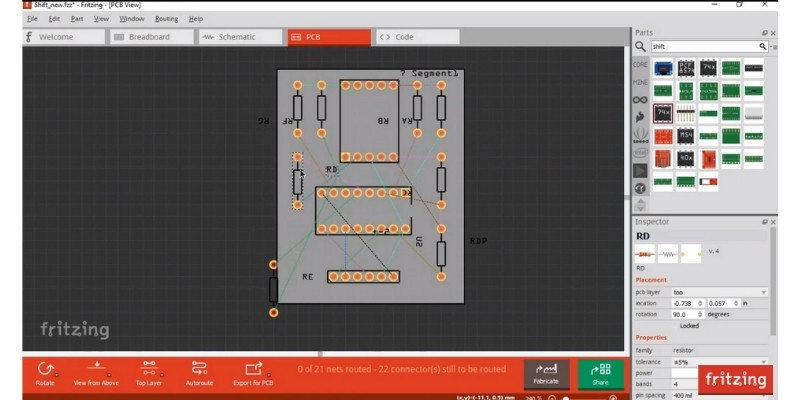
Pros
Open source
Free to use with no limits
Very active user community
Helping learning resources
Cons
Can take longer to learn than other PCB programs
Fritzing is a open source CAD software for PCBs. It’s completely free to use, and unlike CircuitMaker, Fritzing doesn’t limit how many projects you can make with it.
On the flip side, it doesn’t boast the same sleek design and intuitive environment of some other PCB software, so it can take a fair while to get used to. However, it does offer a range of great tools for making PCB layouts, and there are some helpful learning resources to get started with.
Fritzing is probably the most community-based PCB design software on the market. You can get an idea of what you can do with the program by checking out other users’ projects, which include some really interesting and creative things like a soil humidity measurer, musical note detector, a motion sense, and even the famous Snake game – all created using the PCB layout software.
There’s also a forum where you can open discussions and interact with other users, and if you’re a programmer you can use the source code to help fix bugs and develop your own features. So if you’re looking for the best open source PCB software, Fritzing is the one for you.
Best Paid Software for PCB Layout Design
10. PADS – Powerful Circuit Board Designer for Professionals & Startups
- Price: from $5,000
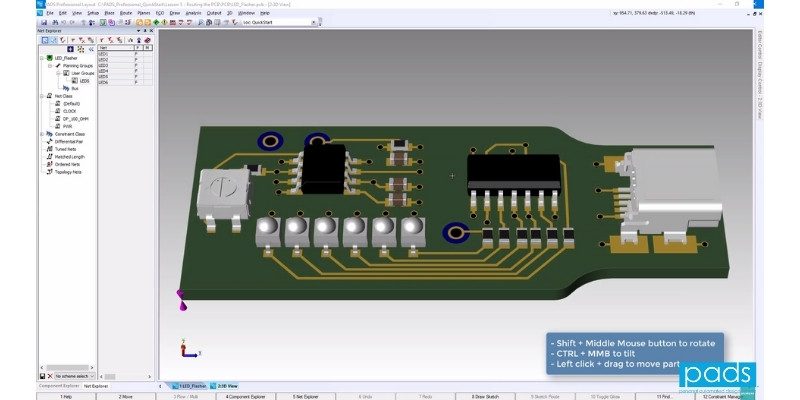
Pros
Variety of solutions for different budgets
Discount program for eligible startups
Cloud-based with great collaborative features
Powerful design capabilities within an intuitive environment
Great support & training
Cons
Too expensive for most individual PCB designers
Another of the best circuit design software is PADS, developed by Siemens Digital Industries Software.
One of the great things about PADS is that it offers several different solutions to suit teams with different budgets and experience levels. For starters there’s PADS Standard, which starts at $5,000 (including support) and provides the core schematic and PCB layout tools in an intuitive environment.
The next step up is PADS Standard Plus, which comes with advanced layout capabilities as well as simulation and analysis tools.
Then you have PADS Professional, a self-contained and integrated schematic PCB design software. This version is compatible with Xpedition technology and is designed to support the entire design and verification pipelines for PCB and hardware engineers, while also providing additional collaborative features.
Finally there’s PADS Professional Plus, the most advanced solution that boasts integrated data management, component research, and real-time sourcing tools.
PADS even hosts a unique program that can provide eligible startups with discounted access to PADS Profesional, which is certainly worth considering if you have a young business that relies on layout PCB software.
11. OrCAD – Dynamic PCB Software Used by Apple, Free for Students
- Price: Upon quote
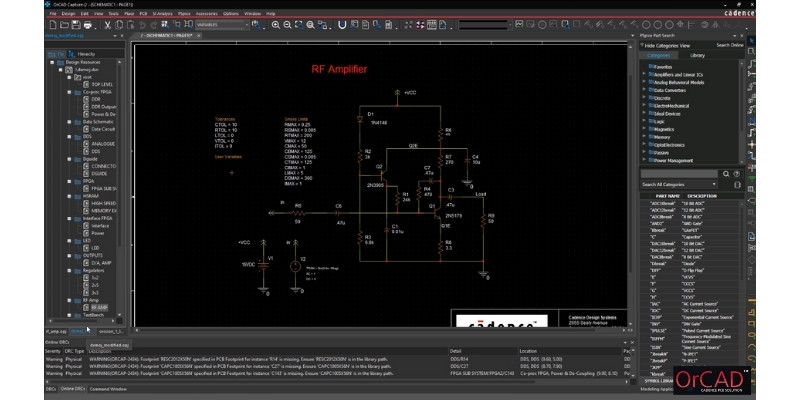
Pros
High quality professional PCB software
Can migrate projects from other programs
High customizable and intuitive environment
Real-time data insights to reduce post-design checks
Free plans for students
Cons
Expensive if you’re not a student
Steep learning curve
OrCAD is one of the best EDA software suites for PCB design. Developed by Cadence PCB Solutions, OrCAD is one of the most powerful, reliable, and comprehensive PCB tools on the market and is used by engineers at Apple and other leading companies.
This program offers all the tools you need to create precise PCB layouts efficiently. It offers real-time design insights, including route, placement, coupling, and impedance analysis, to help speed up prototype to production. These helpful tools remove the need to perform post-design DFM checks which can end up causing much more work if errors are spotted after the design process.
Another benefit of OrCAD is the dynamic differential pair routing, which makes it easy to meet length and phase pin-to-pin constraints because traces can bend without causing any electrical issues. You can switch between 2D and 3D in this software’s highly intuitive and interactive environment, allowing you to examine each aspect of your layouts.
These features only touch the surface of what’s on offer at OrCAD. With a customizable interface, manufacturability checks, schematic capture and simulation, data management, collision detection, and Pspice design tools, it’s one of the most comprehensive PCB design software out there.
You can also migrate your PCB designs to OrCAD from other popular programs like Altium, Eagle, and PADS, with guides on how to do so for each different software.
Finally, there’s also the OrCAD Academy. This allows you to download and use the software for free if you’re a student, and there are also plans for teachers and universities.
Buying Guide – Things to consider when choosing PCB design software
Wondering what makes a good PCB software? Here are the key factors to consider when conducting a PCB design software comparison.
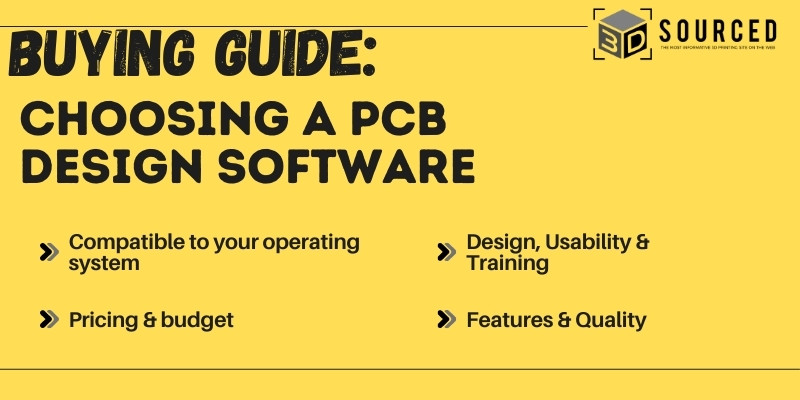
Compatibility
The first thing you need to check when considering a printed circuit board design software is what operating systems it’s compatible with. For example, if you’re looking for a PCB software for Linux or Mac, you can’t use a program like Altium (which is among the most popular PCB software out there) as it’s only available on Windows. Luckily, programs like Eagle are available on Mac and Linux as well as Windows.
If you’re looking for an online PCB designer that doesn’t require download there aren’t many options, though EasyEDA is one solution.
Price & Budget
The cost of the best PCB software varies greatly, from free programs like CircuitMaker to professional solutions like Altium Designer that cost more than $300 a month. There are also the likes of Eagle, which have limited free versions and unlimited paid versions.
Luckily, the top programs from our PCB design software list like Altium and OrCAD offer free trials, so you can use these to try them out before committing to hefty fees.
Design, Usability & Training
There’s no denying that some software are better designed and easier to use than others, and it’s often the more professional paid solutions that are the most intuitive. For example, if you compare an open-source program like Fritzing PCB design software to a professional program like Altium, the latter is noticeably better laid out, has a sleeker design, and is much more intuitive.
Features & Quality
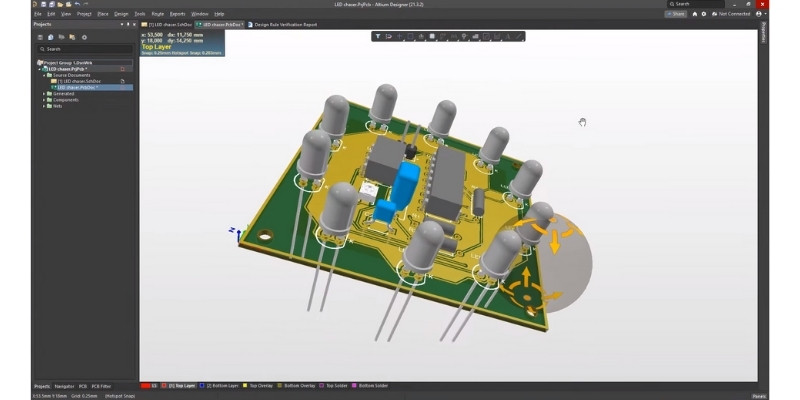
All the PCB software we’ve reviewed generally offer the same core layout and schematic design features, but the quality varies a lot depending on the program. For example, the 3D renderings offered by professional solutions like Altium are considerably higher quality than those you get in free programs.
There’s also variation in the quality and availability of other features, such as schematic simulation, component sourcing, data management, autorouting, design insights and checking, and collaborative tools.
For example, OrCAD offers a great range of real-time insight tools that help reduce the need to post-design checks and can help improve efficiency, while PADS Professional Plus and Altium Designer offer a wide variety of component sourcing, data management, and supplier research tools that you don’t get with free programs. So, make sure you check that a PCB program offers the features you need before jumping in.
Who Uses PCB Design Software?
PCB design software and circuit design tools are primarily used by engineers to create printed circuit boards for use in a wide variety of consumer and commercial electronics.
Commercial electronic products that use PCB boards include smartphones, tablets, computers, and home appliances like fridges and microwaves. Industrially, PCBs are used in medical devices, LEDs, automotive and aerospace components, telecoms devices, security equipment, and maritime and military applications.
Aside from engineers, the other major users of PCB software are teachers, who teach PCB design to students in schools, colleges, and universities.
Downsides to PCB Software
One thing to know before jumping into PCB design is that it’s a pretty complex task, and most PCB design tools have a fairly steep learning curve. So, expect to spend some time learning and reading or watching tutorials before you can start designing PCBs.
The best software for PCB design is also expensive, with the top programs costing hundreds of dollars per month. While this isn’t an issue for engineering companies, it does mean that starting out in PCB design or doing it as a hobby can be pretty costly.
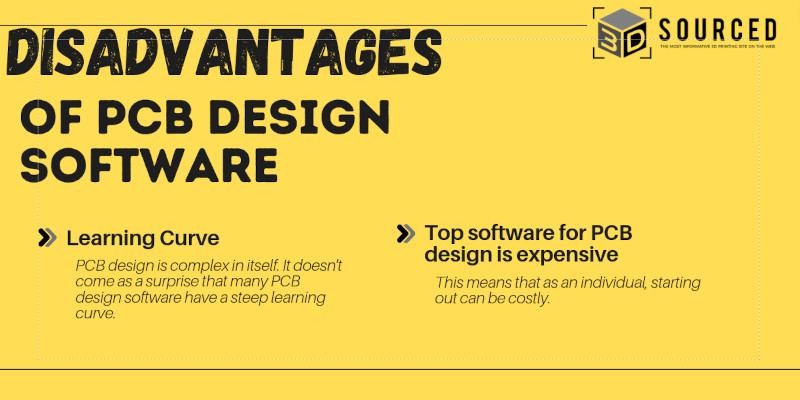
FAQs
Related articles:
- Start Designing ASAP Using The Best CAD Software for Beginners
- Highest Ranked Boat Design Software [Free & Paid Options]
- Ranking The Top Basement Design Software & Apps [All Skill Levels]
- Here Are The Best Free & Paid 3D Animation Software

